Introduction
Workforce planning is the pillar on which manufacturing companies' ability to face unprecedented industrial challenges and embrace the imperative of constant adaptation rests. In a landscape where innovation and agility are the watchwords, only organizations with a strategic, forward-thinking workforce management strategy can hope to not only survive, but thrive in the future.
This article explores the essential strategies and innovative solutions to master this vital aspect, highlighting the crucial importance of integrated and effective workforce planning. As you navigate through the complexities of an ever-changing industry, discover how to position your company at the forefront of transformation, ready to meet tomorrow's challenges.
1- Identify existing skills
The first crucial step in optimizing workforce planning is recognizing and in-depth skills assessment within the company. Recognizing each employee's skills enables optimized management of human resources, adapted to the industry's current and future challenges.
Talent mapping
Build a talent mapping is a fundamental exercise for any manufacturing company looking to the future. This detailed process provides a clear view of each individual's skills and how these interrelate to benefit the productive ecosystem. Such a management tool offers the opportunity to highlight key competencies while identifying any missing skills.
Gap management
In the manufacturing sector, the managing skills gaps is an important issue that can influence the pace and quality of production. A well-thought-out analysis of future needs and an appropriate action plan are required to make up for these shortfalls, through training policies or recruitment.
| Competence | Current status | Future needs |
|---|---|---|
| Robotics | Limited | To be developed |
| Predictive maintenance | Basic | To be reinforced |
2- Anticipating future needs
Understanding and anticipating the competitive demands that will define tomorrow's industry is essential to maintaining a sustainable competitive edge.
Technology watch
Technology watch is a key factor in predicting future skill requirements. Immersing ourselves in current trends and technical advances guides decisions on how to develop the skills needed to stay competitive.
Strategic development
The strategic development of skills includes the definition and implementation of initiatives to training in line with the company's long-term aspirations, including the identification of the skills that are essential to its future.
| Innovation | Capability | Training to be considered |
|---|---|---|
| Renewable energies | To be consolidated | Specialized program |
| Green logistics | New | Integration in progress |
3- Plan appropriate training
The targeted training is the tool by which a company consolidates its team for future challenges, ensuring a competitive edge thanks to a skilled and versatile workforce.
Mentoring programs
Visit mentoring programs facilitate the efficient transmission of knowledge and foster a climate of learning and collaboration. This optimizes the staff integration process and enhances the value of the company's human capital.
Career paths
Establishing structured career paths aligned with corporate objectives is an important lever. By specifying the training required at each professional stage, employees can evolve serenely and efficiently, offering greater value to their organization.
4- Use digital tools for your workforce planning
The integration of digital technologies is radically transforming the workforce planning landscape.
Analytical tools
Analytical tools are modernizing and transforming human resources management, bringing predictive capabilities and improvement strategies based on real, accurate data for training plans and recruitment.
Collaborative platforms
Visit collaborative platforms reinforce training management and communication within manufacturing companies. These solutions support better coordination of educational projects while engaging all stakeholders in a continuous and efficient process.
5- Strengthening strategic dialogue
Alignment and communication between HR and operational departments are essential for a successful workforce planning strategy.
HR-operational commitments
The symbiosis between HR departments and operational is a guarantee of more aligned and strategic talent management. Fluid communication helps reconcile workforce needs with production imperatives.

Know-how governance
Know-how governance is the art of structuring and supervising skills so that they serve the company's strategic goals. This means constantly monitoring the fit between talent development and the company's growth objectives.
Conclusion
These steps pave the way for optimizing workforce planning to meet the expectations of an ever-changing manufacturing industry. They underline the importance of a workforce management strategy that is adapted and responsive to change.




